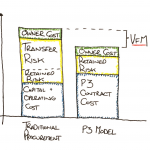Any discussion of sustainable development is in itself problematic, as it suggests developing or improving upon something that is constant or unchanging. If this logic is used to critically evaluate sustainable capitalism, then it too is a flawed concept. This paper stands to illustrate the problems associated with the concept of sustainable capitalism and review potential steps that will allow a transition from carbon dependency to a system based on clean energy.
“While there are many variations of economic growth theory, all presuppose that capitalism cannot stand still; that the system must expand or contract…” (O’Connor 1998: 240). Within this statement lie the first and second contradictions to capitalism; the first contradiction states that when capital tries to increase profits by reducing costs at the expense of the labour force, (i.e. mechanization/automation, or wage reductions); it reduces the spending money of consumers and inadvertently causes a reduction in consumer demand, a demand-side crisis. The second contradiction of capitalism states that “capital limits itself by impairing its own social and environmental conditions, hence increasing the costs and expenses of capital…” (O’Connor 1998: 159). This contradiction assumes that individual capitals offset the economic costs of increased production onto society and the environment (climate change /water contamination/ noise pollution/ etc.), which evades the short-term costs but increases the negative long-term effects. With this reasoning it’s plausible to state that for capitalism to be sustainable it must commoditize its own barriers; that is, it must create a market for alternative energy, environmental cleanup and monitoring, occupational health and safety, and so on, so that these elements become part of, rather than against the capitalist system.
Carbon offsetting has created such a step, wherein it provides incentives for carbon reduction by penalizing activities/methods of production that are carbon intensive. The income generated from this method would “allow industrialized countries to meet their [Kyoto] emission reduction targets by purchasing emission reductions that are associated with projects in the developing world…” (Bumpus 2008: 128). While this step works to help reduce the problem, it alone is far from the answer. Over time many problems have arisen from carbon offsetting, which is to be expected as this method should be viewed as a step in the right direction rather than the solution to the overall problem.
Environmental taxation is another step to reduce carbon dependence, in which indirect taxes are implemented on fossil fuel inputs such as coal and oil, and outputs like gasoline and propane, in proportion to their carbon content (OECD 2010). Carbon taxation acts as a disincentive for the consumption of fuel, and promotes energy conservation. This model works similar to carbon offsetting by providing incentives to reduce carbon usage, but it does so in a manner that consumers can calculate directly. In July of 2008, the Province of British Columbia became the first region in North America to apply a consumption-based environmental tax to reduce carbon emissions. This tax is intended to be “revenue neutral”, as the revenue generated from the tax is used to reduce personal and corporate income tax, and create a tax credit for low-income households. Environmental taxation can also be used to fund carbon reduction techniques, as seen in Quebec (Duff 2009). In both cases the income generated remains within each province, rather than going to developing nations.
While carbon offsetting and taxation help provide incentives to reduce carbon dependence through local and global funding for a sustainable energy system, they alone do not provide the solution. These incentives and disincentives have been introduced to many nations and corporations, but are not well monitored or enforced. As such, there is a need to create a governing body or bodies to oversee progress and further develop the system.
This calls upon individual governments to develop “national expenditure policies that heavily subsidize alternative energy sources; technological research that leads to eliminating toxic chemicals and other substances at the source; innovations in mass transit; occupational health and safety conditions; national, regional and community enforcement procedures; and a redefinition and reorientation of scientific and technological priorities generally.” (O’Connor 1998: 237). This action will be met with resistance from both industry and society as it removes some elements of free will by imposing requirements and restrictions on production and consumption. Governmental involvement, however, plays a key role in redefining our use of energy as it has the ability to improve the progress of sustainable capitalism and reduce the timeframe through subsidies and enforcement. There is a narrow “window of sustainability” in which the economy must pass through. According to professor Tim Jackson of the University of Surrey, “if we invest too slowly, we run out of resources before alternatives are in place…if we invest too fast, there’s a risk of slowing down the economy to the extent that resources required for further investment aren’t available” (Jackson 2009: 50).
Therefore, government involvement needs to be brought in methodically to encourage cooperation rather than enforcing it. This can begin with methods like carbon taxing and offsetting, which will help subsidize the infrastructure mentioned above. Involvement by a governing body is necessary, as the task is too large to assume individuals will effectively take it upon themselves to organize and commit to a plan in which short-term profits are reduced, for a hope of long-term gains that may not be realized in their generation. For this reason, a global shift in the way individuals consume their resources must also accompany the change.
For too long developed nations, especially continental North America, have had seemingly unlimited access to cheap energy and this has fostered nations driven by over-consumption. The capitalist modality of wealth accrual and profit maximization has created an egocentric outlook, which places little emphasis on externalities created during the process. The availability of cheap energy has also allowed the development of steadily rising wages; therefore, as the cost of energy increases there will likely be an effort on the part of capital to cheapen labour, which again brings up the first contradiction to capitalism (Abramsky 2010). Developed societies need to move from a consumption-dominated behaviour to one that promotes conservation. The solution begins with increasing the cost of carbon intensive activities by creating a market for the externalities of production, and through direct and indirect taxes on consumption. In the process, new markets will be created for economic opportunities but it will be important to regulate these markets so that the wealth is shared among the people, not only going to the hands of a few large corporations or nations.
Society needs to find a way to subsidize or finance a transition to cleaner energy sources that will not induce a crisis in the economic system. We need to find a way to effectively switch from readily available, cheap energy, and move to an energy system that promotes a conservative outlook on energy usage through disincentives and incentives. For the above reasons it is especially critical that this shift is implemented by both industry and society, as this is an issue that cannot be fixed quickly, but must be brought into global culture and created as a social norm.
Literature Cited
Abramsky, Kolya. Sparking a Worldwide Energy Revolution. AK Press: Denver, 2010. Print.
Bumpus, Adam, Diana Liverman. “Accumulation by Decarbonisation and the Governance of Carbon Offsets.” Economic Geography 84.2 (2008): 127-155. Print.
Duff, David. “Carbon Taxation in British Columbia.” Vt. J. Envtl. L. 87.1 (2009): 93-101. Print.
Jackson, Tim. “Recovery without growth?” Renewal 17.3 (2009): 43-56. Print.
O’Connor, James. Natural Causes. Guilford Press: London, 1998. Print
OECD. “Taxation, Innovation, and the Environment.” OECD Publishing: New York, 2010. Web. 02 November 2010.





